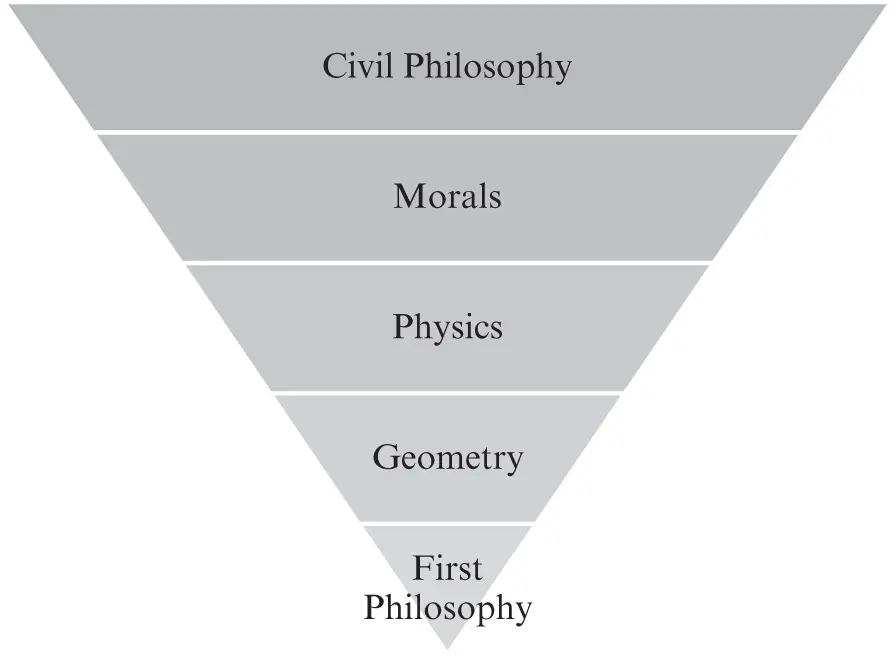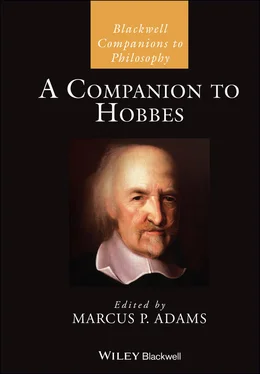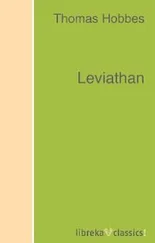4.1 Statements about the Relationships amongthe Parts of Philosophy
Hobbes reflects on the relationships among the areas of his philosophy in several places in the corpus, but his most extensive reflection upon these relationships is in De corpore VI.6. At first glance, it may seem that Hobbes is advancing a reductionist program along the following lines: all natural phenomena are reducible to minute bodies in motion. If this reductionist picture is correct, then it looks as though the parts of philosophy can be organized from first philosophy to physics, and from “morals” to civil philosophy, with first philosophy serving as the foundational discipline for all philosophy, as displayed in Figure 4.1.

Figure 4.1Hierarchy of the parts of philosophy.
Indeed, in De corpore VI.6, Hobbes details how one should begin from the knowledge of the “universals” of first philosophy, such as the knowledge of what “place,” “body,” and “motion” are, and then use that knowledge to develop geometrical definitions. For example, using the knowledge of such universals as these one can form the definition of “line” as that which is “made by the motion of a point” (OL I.63; Hobbes 1981, 297). After working in geometry, which he says studies motion simpliciter , Hobbes suggests that there should be a general study of “those things which occur from the motion of the parts” (OL I.64; Hobbes 1981, 299). This will lead to considering “sensible qualities” such as light, color, sound, odor, and flavor, but before these can be explained the human senses that perceive these qualities must be understood. These third and fourth parts of philosophy together constitute physics ( physica ).
Finally, Hobbes notes that “[a]fter physics we come to morals” in which desire and aversion, and passions generally, are examined as “motions of the mind” (OL I.64; Hobbes 1981, 299). He explains that the reason why the study of the passions follows physics is that the passions have their “causes in physics” (OL I.64; Hobbes 1981, 299). Hobbes concludes this reflection on the relationships among the parts of philosophy by claiming that anyone who attempts to engage in natural philosophy without taking principles from geometry will be making vain attempts. Furthermore, he declares that anyone who engages in such useless activity will “abuse their listeners” (OL I.65; Hobbes 1981, 301).
This reflection Hobbes offers about natural philosophy and its relationship to the other parts of philosophy suggests a deductive relationship, and many Hobbes scholars have argued that such a view was Hobbes’s (Martinich 2005; Peters 1967; Shapin and Schaffer 1985; Watkins 1965). An even stronger view sees Hobbes as a type of reductionist (for example, Hampton 1986; Ryan 1970). For example, Alan Ryan offers a version of this reductionist interpretation of Hobbes as follows:
Hobbes believed as firmly as one could that all behaviour, whether of animate or inanimate matter, was ultimately to be explained in terms of particulate motion: the laws governing the motions of discrete material particles were the ultimate laws of the universe, and in this sense psychology must be rooted in physiology and physiology in physics, while the social sciences, especially the technology of statecraft, must be rooted in psychology.
(1970, 102–3)
As is clear from the De corpore VI.6 passage discussed already, there is some textual support for this understanding of Hobbes’s philosophy. If this view that ultimately all behavior of matter is explained in terms of the most basic physical laws is correct, then we might expect that in Hobbes’s actual practice he would provide explanations that appeal to more “basic” particles and laws about how those particles behave. Furthermore, we would expect him to provide bridge principles stating how statements about macroscopic entities, like human bodies or commonwealth (artificial) bodies, reduce to statements about microscopic entities.
A significant difficulty faces the deductivist and reductionist interpretations: How would a deduction or reduction actually work between, say, a statement in “morals” and statements in geometry or physics? Consider the concept of “endeavor,” which Hobbes introduces in De corpore XV.2 (in Part III on geometry) and then uses again within civil philosophy to describe the motions of human bodies, since the passions are endeavor (2012, 78; 1651, 23). Although endeavor is used in geometry, moral philosophy must add information about human passions understood as endeavor. As will be discussed, Hobbes describes this very need to supplement with additional information in De homine X.5 as needing to have “knowledge of the subject” (in Hobbes’s description of the relationship between pure geometry and mixed mathematics; Hobbes 1994b [1658], 42; OL II.93). In particular, the properties “appetite” and “aversion” are added, but these properties obviously do not apply to all bodies in general. As a result, endeavor in human bodies (the passions) will not be reducible to endeavor in geometry (for similar discussion, see Malcolm 2002, 147). Were this reduction what Hobbes had in mind, we would expect him to provide bridge principles to show how “endeavor” in human bodies can be reduced to “endeavor” in bodies in general.
Two additional statements that Hobbes makes in the surrounding context of De corpore VI.6 further complicate things for the deductivist or reductionist interpretations. First, after making the link between physics and morals, he advises that what he has described is the order of investigation:
That all these things ought to be investigated in the order I have said [ Haec autem eo ordine quem dixi investiganda esse ] consists in the fact that physics cannot be understood unless the motion which is in the minutest parts of bodies is known and such motion of the parts unless what it is that effects motions in another thing is known, and this unless what simple motion effects is known.
(OL I.64–5; Hobbes 1981, 299–301)
Labeling this as about the order of investigation suggests that one should engage in preparatory work in First Philosophy and geometry before attempting to provide explanations in natural philosophy or about the human passions. As will be discussed, understanding these comments as about the order of investigation , and not as advocating for a deductivist or reductionist mode of explanation, makes sense of Hobbes’s actual practice of natural philosophy where one borrows (already known, and thus first in order) causal principles from geometry for use within an explanation.
Second, Hobbes’s discussion in De corpore VI.7 further confounds claims that he held a deductivist or reductionist view. There Hobbes states that although civil philosophy is connected to “morals,” the latter of which is connected to the other parts of philosophy, civil philosophy can be “detached” from it because the “causes of the motions of the mind are not only known by reasoning but also by the experience of each and every person observing those motions proper to him only” (OL I.65; Hobbes 1981, 301).
How is this flexibility for learning the “principles of politics” possible according to Hobbes? Elsewhere, Hobbes distinguishes between two paths that one can take in philosophizing – synthesis and analysis – and he incorporates these two paths in definitions of “philosophy” in De corpore (for example, in De corpore I.2; OL I.2; Hobbes 1981, 175). Hobbes uses synthesis and analysis simplistically, sometimes calling them compounding or composing and resolving and other times calling them adding and subtracting (for example, De corpore VI.1; OL I.59; Hobbes 1981, 289). For example, he describes how the conception “square” is resolved in analysis into “plane,” “bounded by a certain of lines equal to one another,” and “right angles,” which parts of “square” are further resolved into the “universals or components of every material thing: line , plane (in which a surface is contained), being bounded , angle , rectitude , and equality ” (OL I.61; Hobbes 1981, 293). Then, those component parts are put back together (in synthesis), and by doing so learns that these parts are the “cause of square.” 2
Читать дальше













